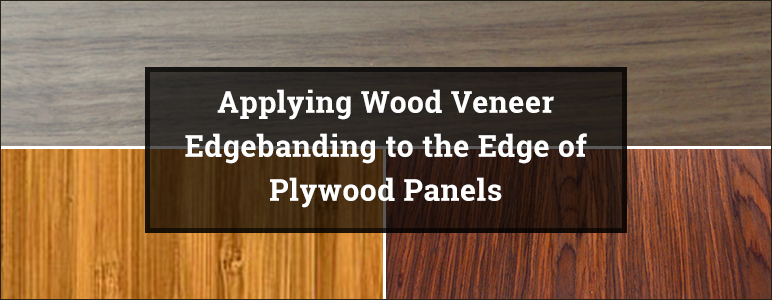Wood Edgebanding, Wood Veneer
Applying Wood Veneer Edgebanding to the Edge of Plywood Panels
Plywood edges are often unsightly and need to be covered. Edge Banding is a simple procedure that will hide these edges and protect them. The end result is an appearance of solid wood throughout the panel.
What is Edge Banding?
Edge banding is slices of wood veneer or wood veneer sheets applied to the edges of pressed wood which can be plywood, particle board or MDF (medium density fiber board). It is produced using thinly sliced sections of trees or logs that are joined together with a staggered finger joint that flows with the length of the product. It will accept most any stain or finish unless the product is prefinished.
There are a couple of approaches to working on the plywood edges, but veneer edge banding is the ideal approach and the most preferred. This quick procedure makes clean edges that give a project an ideal appearance and protection from moisture and warping for the panel.
Types of Edge Banding
There are various approaches to Edge Banding, all with multiple outcomes and applications. Widths are available from ¼” – 6” for thin and 7/8” – 2” in thicker edgebanding.
- Thin veneer edgebanding in roll form
- Thick veneer edgebanding 1-2-3mm in roll form
- Preglued wood veneer edgebanding
- Nonglued wood veneer edgebanding
- Wood veneer strips cut from paper backer wood veneer sheets
How to Choose the Most Effective Veneer Edge Banding?
Veneer edge banding from JSO Wood Products is available in many species of wood veneer. Availability of thin veneer is better than that of thick veneer edgebanding. It is best to use a product that is slightly oversize and can later be trimmed after gluing. Our edgebanding trimmer tool is an excellent option for accomplishing this, but a simple razor knife or router can be used also.
How to Apply Thin Veneer Edge Banding?
- Prepare the surface edge and sand smooth if needed. Fill any large gaps, unpleasant sand spots, and eliminate dirt and dust.
- Use a household or industrial iron turned to the cotton setting or 390 degrees. A protective cloth or release paper can also be used.
- Cut a segment of tape 1-inch longer than required and loosely arrange it to be applied to the edge in best manner possible.
- Apply the edgebanding to the edge as it can be heated up and line it up with the edge as you go.
- Position the squared edge on the edge of your pressed wood or other substrate and smooth it with a couple of passes of an iron.
- Apply pressure to the product as it cools. Our wood veneer scraper tool is an excellent option here. It has a handle and a fiberglass blade. Other option will work well also. Wood blocks and other flat blade type of products.
- Trim the excess veneer from the edge with our edgeband trimmer tool or a razor knife or router until the edges are melded closely and none is left to hang over.
- Final sand once the product is secured to the edge.
- Product will be ready to finish immediately upon cooling.
In Need of Expert Assistance for Veneer Edge Banding?
JSO Wood Products is a wood veneer and edge banding company. We have specialized personal services for a wide array of woodworkers in various industries. Experience from 1995 in both small and large scale edgebanding projects.
Reach us at steve@jsowoodproducts.com or call us at 502-425-2541 for help.
